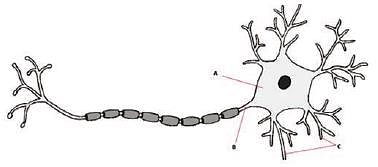Olympiad Test: Classification - 2 - Class 5 MCQ
15 Questions MCQ Test - Olympiad Test: Classification - 2
The part of the human brain which is an important relay station for the sensoryimpulses and is also the origin of many of the involuntary acts of the eye such as the narrowing of the pupil in bright light is the:
| 1 Crore+ students have signed up on EduRev. Have you? Download the App |
The nervous system develops from which germ layer?
Which of the following is an example of striated tissue?
Identify the parts labelled as A, B, and C in the figure and select the correct option.


Choose the correct answer that is part of the peripheral nervous system.
Which of the following statements is/are true about the sense of touch?
Which of the following activities is/are controlled by the somatic nervous system?
Which part of the body produces a response to stimuli?
The thin layer of tissue that lines your eyelids and nasal cavity is called the:

















